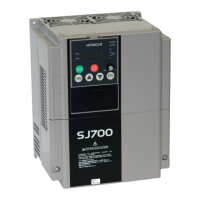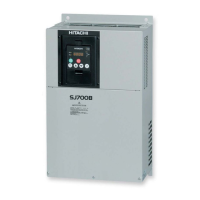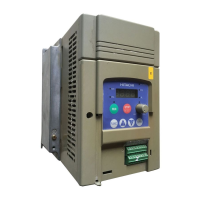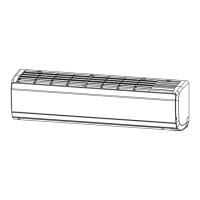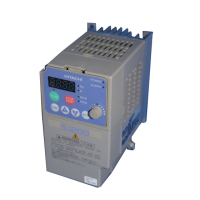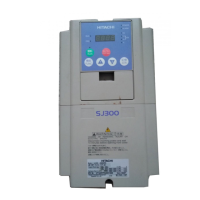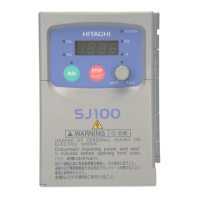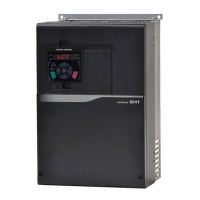Chapter 4 Explanation of Functions
4-89
4.2.96 Sensorless vector control
The sensorless vector control function estimates and controls the
motor speed and output torque on the basis of the inverter output
voltage and output current and the motor constants set on the
inverter. This function enables the inverter to accurately operate the
motor with a high starting torque, even at a low frequency (0.3 Hz
or more).
To use this function, specify "03" for the V/F characteristic curve
selection (A044/A244).
Before using this function, be sure to make optimum constant
settings for the motor with reference to Section 4.2.91, "Motor
constant selection."
When using this function, observe the following precautions:
1) If you use the inverter to drive a motor of which the capacity is
two classes lower than the maximum applicable capacity of the
inverter, you may not be able to obtain adequate motor
characteristics.
2) If you cannot obtain the desired characteristics from the motor driven under the sensorless vector control,
readjust the motor constants according to the symptom, as described in the table below.
Momentary speed
variation is negative.
Increase the motor constant R2 step by step from the set
value up to 1.2 times as high as the set value.
Momentary speed
variation is positive.
Reduce the motor constant R2 step by step from the set
value down to 0.8 times as high as the set value.
Torque is insufficient at
low frequencies (several
Hz)
Increase the motor constant R1 step by step from the set
value up to 1.2 times as high as the set value.
Increase the motor constant Io step by step from the set
value up to 1.2 times as high as the set value.
The motor generates an
impact when it starts.
Reduce the motor constant J from the set value.
The motor runs
unsteadily.
Reduce the speed response setting.
Reduce the motor constant J from the set value.
Torque is insufficient
during torque-limited
operation at a low
frequency.
Reduce the overload restriction level to lower than the
torque limiter level.
Motor rotation is
inconsistent.
Increase the motor constant J from the set value.
Motor runs backwards for
short moment.
Set 01 (enable) on reverse run protection function (b046)
Note 1: Always set the carrier frequency (b083) to 2.1 kHz or more. If the carrier frequency is less than 2.1 kHz, the
inverter cannot operate the motor normally.
Note 2: When driving a motor of which the capacity is one class lower than the inverter, adjust the torque limit (b041
to b044) so that the value "" calculated by the expression below does not exceed 200%. Otherwise, the
motor may be burnt out.
= "torque limit" x (inverter capacity)/(motor capacity)
(Example) When the inverter capacity is 0.75 kW and the motor capacity is 0.4 kW, the torque limit value is
calculated as follows, based on the assumption that the value "" should be 200%:
Torque limit (b041 to b044) = x (motor capacity)/(inverter capacity) = 200% x (0.4 kW)/(0.75
kW) = 106%
A001: Frequency source setting
A044/A244: V/F characteristic curve selection, 1st/2nd
motors
F001: Output frequency setting
b040: Torque limit selection
b041 to b044: Torque limits (1) to (4)
H002/H202: Motor data selection, 1st/2nd motors
H003/H203: Motor capacity, 1st/2nd motors
H004/H204: Motor poles setting, 1st/2nd motors
H005/H205: Motor speed constant, 1st/2nd motors
H020/H220: Motor constant R1, 1st/2nd motors
H021/H221: Motor constant R2, 1st/2nd motors
H022/H222: Motor constant L, 1st/2nd motors
H023/H223: Motor constant Io, 1st/2nd motors
H024/H224: Motor constant J, 1st/2nd motors
H050/H250: PI proportional gain, 1st/2nd motors
H051/H251: PI integral gain, 1st/2nd motors
H052/H252: P proportional gain setting, 1st/2nd
motors
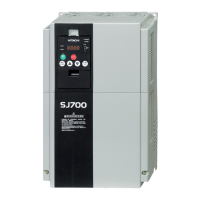
